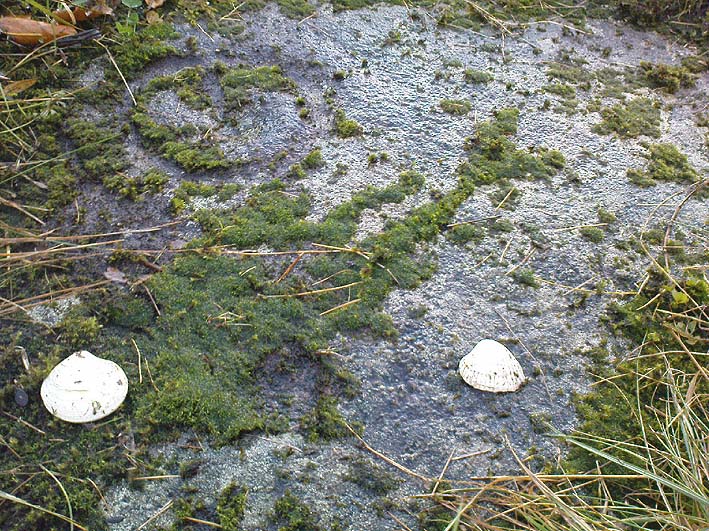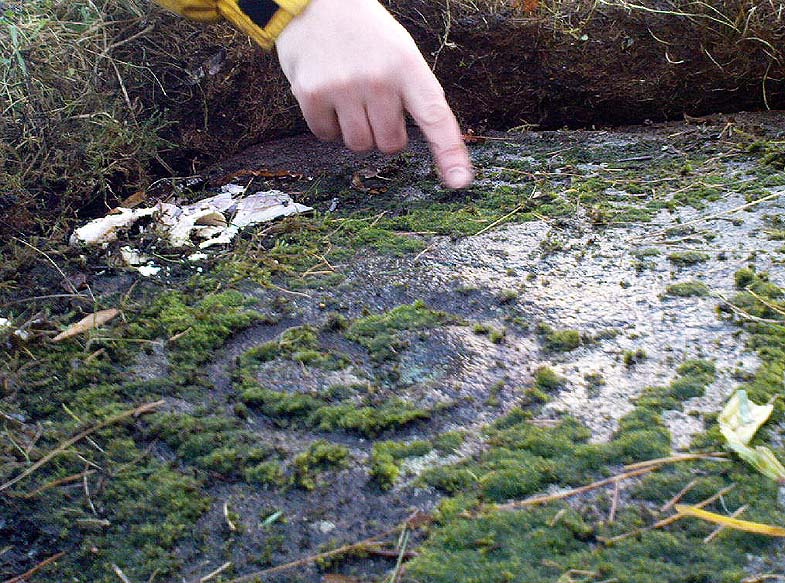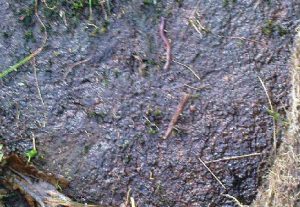Cup-and-Ring Stone: OS Grid Reference – NS 7837 9299
Also known as:
- CEN 12 (R.W.B. Morris survey, 1981)
Getting Here

Not too hard to find really. On the far western edge of the King’s Park golf course, head for the highest point where the small cliffs drop down. From here, walk down the footpath on the slight slope south, just below where the small copse of trees are, and you’ll see the singular small flat stone in the grasses near the footpath you’re walking along. If you can’t find it – look around!
Archaeology & History
A little-known but fascinating isolated carving, first described by David Morris at the sixth meeting of the Stirling Natural History and Archaeological Society in 1901. It is found on the western edge of the town, above the rocky edges not far from the pond of St. Thomas’ Well on the far edge of the golf course. Morris’ finding was written up in their fine journal, where he wrote:
“In the King’s Park, about 50 yards east of the cliff where a seat overlooks the Douglas Terrace sand quarry, there is a smooth surface of rock showing through the turf, measuring two-and-half feet by one-and-half feet… On it is a cup-shaped hollow, outside the rim of which is a well-marked hollowed ring, beyond which is another faintly marked, concentric circular groove. The cup-mark measures one-and-a-half inches across; the inner rim of the first circle is 4 inches, and the outer rim is 6 inches in diameter. The outer circle, if complete, would be 9 inches in diameter. The depth of the central hollow is half-an-inch, and of the inner groove fully one-quarter of an inch. The markings are plainly artificial…”

In good sunlight, it is obvious that the carving is a fine example of a double-ringed cup-and-ring carving – though the outer ring may not be complete. The Scottish Royal Commission lads told that “this rock outcrop bears three cup marks” – one of which has the rings surrounding it. In the first photo here, the southernmost cup-marking is highlighted in the centre of the two shells which were on the rock when we arrived.
However, there’s definitely more to this carving than previous investigations have outlined. It seems that the northernmost cup-mark has a ring and a possible outer-ring. There is also a distinctive linear carving, which at first seems like a primitive triangle, just below the southernmost cup – as we’ve tried illustrating here in the photo which Mikki Potts took. It’s faint, but once you see it, it’s obvious that it’s there. Other faint lines of similar nature also seem apparent near the northernmost cup-marking, but we will have to wait for rubbings and further visits in better light to ascertain the full image on this rock. Well worth checking out if you like your rock art! (can any of you Scottish rock-art fanatics have a closer look at this? – take a rubbing of it and see what other aspects are on this design)

One other thing which seemed apparent when we were here: this site has all the geomantic hallmarks of accompanying a burial at some time in the ancient past. Its isolation here is unusual and the carving is only 50 yards from the highest point hereabouts, where you have 360-degree views all round, typifying the position of many prehistoric tombs.* Does anyone know about such features, or have records of any field-name surveys taken, which might confirm or deny this thought? Twouldst be good to know!

References:
- Feachem, Richard, Prehistoric Scotland, Batsford: London 1963.
- Morris, David B., “Cup and Ring Marked Rock Surface in King’s Park,” in Stirling Natural History & Archaeology Society Transactions, 1900-1901.
- Morris, Ronald W.B., The Prehistoric Rock Art of Southern Scotland, BAR 86, Oxford 1981.
- Royal Commission on the Ancient and Historical Monuments of Scotland, Stirlingshire – 2 volumes, HMSO: Edinburgh 1963.
- Royal Commission on the Ancient & Historical Monuments of Scotland, Archaeological Sites and Monuments of Stirling District, Central Region, Society of Antiquaries of Scotland 1979.
* Since writing the above, thanks the correspondence of Paddybhoy, we’ve learned that there definitely were prehistoric tombs close by; one being just at the bottom of the ridge below the carving, on Douglas Terrace. Records describe several other prehistoric tombs nearby at Birkhill House, the Birkhill Sandpit and Coneypark Nursery. However, I still think it most probable that there were other tombs and more rock art, probably along the edges of King Park, aswell as the Cambusbarron plain. These need locating.
© Paul Bennett, The Northern Antiquarian
Feachem writes:
“It is interesting to note that in an area of sandy ground a few hundred yards to the S, several bronze age burials have been recorded, including at least one with a beaker”
Prehistoric Scotland, by Richard Feachem and Urho Kekkonen, 1963 PP.93
I was there recently – the cooncil are allowing the golf club and local residents to break up some of the outcrops near this site with a JCB, because young people hang around drinking.
Cheers for the additional info Paddybhoy. Checking thru one of the RCAHMS for Stirlingshire, I’ve found records of several other tombs very close by aswell. I’ll add them onto TNA in the coming days, though sadly there’s very little to be said of them.
Re the local cooncil digging up the land hereabouts: it’d be good to gerrem checked over – or p’raps contact the local archaeo’s (if they can be bothered) and see if they can checked over the land that’s gonna be destroyed. If there’s a group of prehistoric tombs that were here in times gone by, archaeo’s could do with playing a part in any destruction here, to record any other items that’s likely to be uprooted when the JCBs start digging.
Cheers – Pual
I did just that, Paul and contacted the local archeo-officer. She went along and had a look then gave the go-ahead. The strange thing is that the “outcrop” was definitely not natural. When the digger had done its job, you could see that the stones had been set in place. There were packing stones around the bases. Not saying this was neolithic, but now we’ll never know.
And the neds were back tonight.
Hmmmmm… I’m gonna be in Stirling in a month’s time (my daughter’s getting married & lives just by the Castle). If you live nearby, could we meet up. I’d like a look at what’s there and have a bittova scout round, especially if there’s any traces left of these ‘packing stones.’ Any chance you can get the name of the local archaeo-officer? – just in case she aint done her job right.
Sounds like a plan. 07890 296070.
I have some before and after images which I could post … if I figure out how to!
Did you guys meet up? Any conclusions?
No we didn’t. But I live nearby now. Fancy meeting up and giving the site the clean-up it requires? We can see if there’s any more sections of petroglyphs around the edges.
Photos here https://www.flickr.com/photos/peigimccann/19315389374/in/dateposted-public/ and here https://www.flickr.com/photos/peigimccann/19911805376/in/dateposted-public/